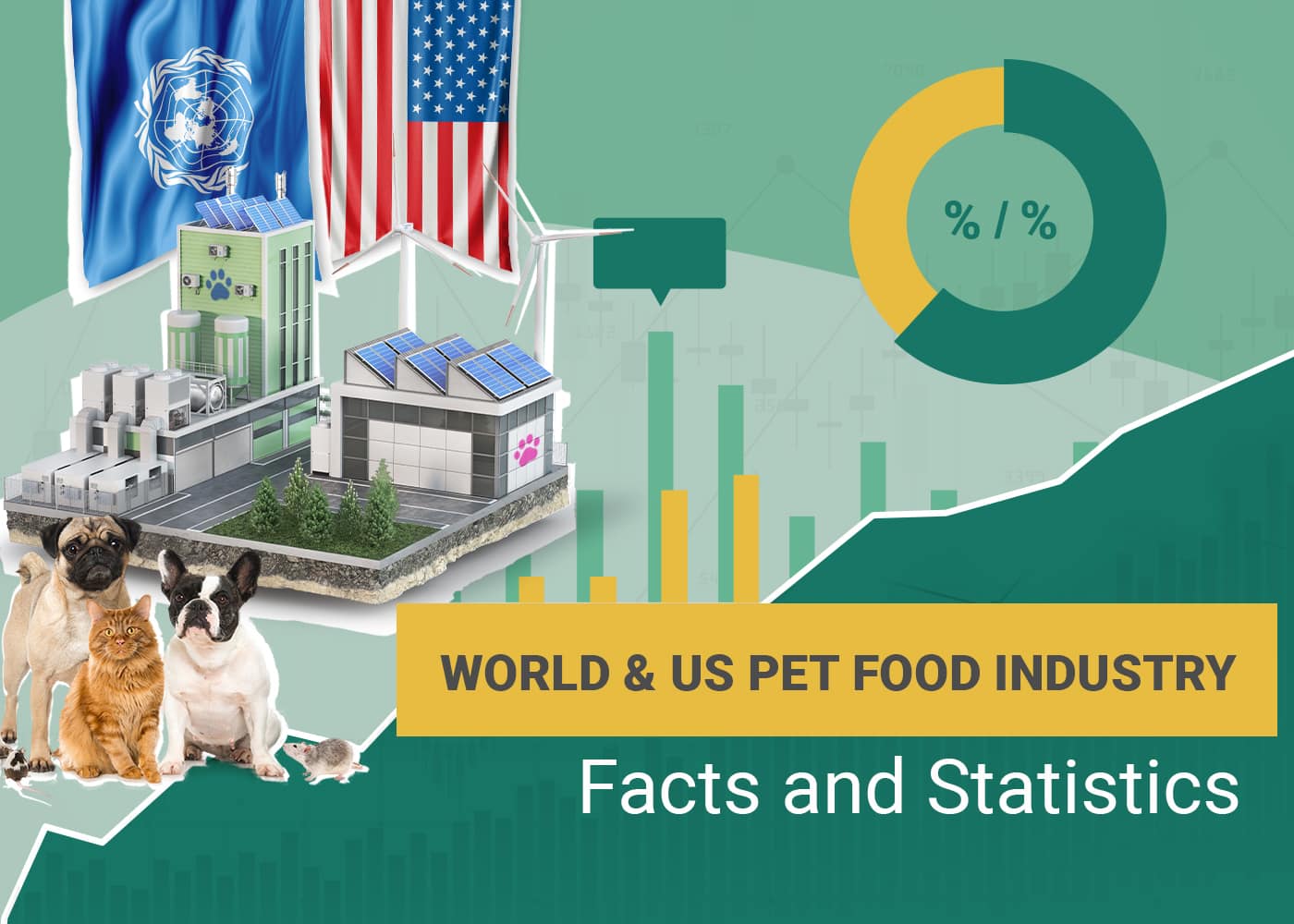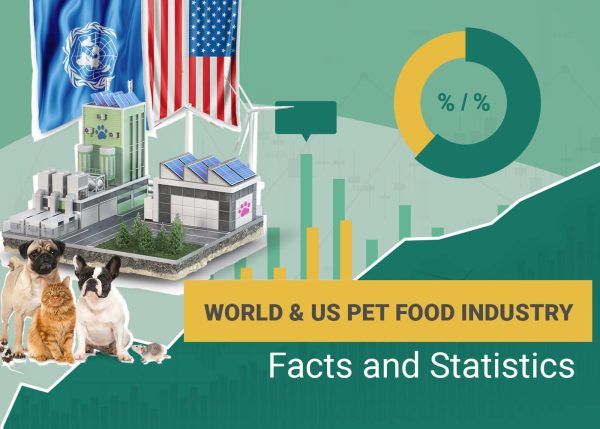Click to Skip Ahead
Note: This article’s statistics come from third-party sources and do not represent the opinions of this website.
Due to the ever-expanding market growth of pet food, it can be hard to keep up with the changing trends. It seems that companies are promoting their recipes and ingredients more than ever in an effort to prove your pet’s health is their number one priority.
As we gain more insight into how nutrition impacts our beloved animals and research continues to shine a light on questionable or outdated practices, we’ve seen many companies transitioning from harmful to more holistic recipes for our pets. But just what does that mean for the pet food industry and how well is it growing as a result? Let’s get into some pet food industry analysis by crunching some numbers.
The 14 Pet Food Industry Statistics
- The US pet industry expenditure for 2021 was at $103.6 billion and is expected to continue rising.
- Pet food was the highest-selling pet market product in 2020—and experts expect to maintain that statistic for 2021.
- Pet food sales are expected to increase around 5.8% in the coming year.
- Pet owners spend an average of $329–$442 on pet food in a year.
- The COVID-19 pandemic has increased pet food sales significantly.
- Online purchases and subscriptions of pet food and related products have reached an all-time high.
- E-commerce options for pet food are projected to take precedence over in-store purchases, even as social distancing restrictions diminish.
- Pet supplement sales jumped up to $1.47 billion in 2020 and are predicted to continue rising.
- Organic pet food continues to gain popularity, seeing $22.8 billion in sales in 2020.
- The vegan market is projected to grow from $9.3 million in 2021 to $15.6 million within 7 years.
- The number of households with pets continues to increase, with 70% of all US homes having at least one pet
- Millennials steal the number one slot for pet owners, making up 32%.
- Pet food production jobs employ nearly 25,000 people and this number is estimated to grow.
- Pet food industry companies are thriving in 2021, with Mars Petcare Inc. taking the lead at $18,085,000,000 in total revenue.

The Ever-Growing Numbers of the Pet Industry
1. The US pet industry expenditure for 2022 was at $103.6 billion and is expected to continue rising.
(American Pet Products)
President and CEO of APPA, Steve King, announced that the pet food industry broke records, exceeding over 103.6 billion dollars this year. These numbers include all products related to pets.
It is speculated that humans turned to their animal companions more than ever because of the unique emotional challenges that 2020 brought.
The pet food market report is broken up into three categories: cat, dog, and others. Dogs dominate this category, being that the dog food market share is 37.16% of the pie chart. That means more than 38 billion is spent on our canine companions alone!

2. Pet food was the highest-selling pet market product in 2020 and experts expect to maintain that growth in 2022.
(Statista)
These projections include everything from pet care to medications, but the bulk of the expense was for pet food, reaching a whopping 42 billion in sales in 2020. These numbers are astronomical, jumping an entire 9.7% from 2019.
3. Pet food sales are expected to increase around 5.8% in the coming year, nearly double the speed of years past.
(American Pet Products)
The historical average of pet sales increases is typically between 3% and 4%. Unlike previous growth years, this coming year is expected to jump by nearly 6%. With the ever-developing e-commerce options and increase in pet ownership, it’s hard to tell where these numbers will stop.

 Pandemic Impact & Online Orders
Pandemic Impact & Online Orders
4. Pet owners spend an average of $329–$442 on pet food in a year.
(Statista)
Dog owners are at the top of the food cost chart, spending an average of $442 on their dog’s diets. Cat owners spent a good amount of cash but still a little less—averaging $329. Numbers are anticipated to increase due to changes in diet options and a continual enhancement of food quality for pets.
As the demand for natural diets goes up, so do the prices.
5. The COVID-19 pandemic has increased pet food sales significantly.
(Pet Food Industry)
Because of the effects of COVID-19, pet sales rose drastically throughout 2020. It seems higher-income households, as well as baby boomers, increased their purchases even more than others. Homes with incomes of about $70,000 increased their pet food purchases by a whopping 25%, and homes with over $100,000 increased by 20%—no small amount.
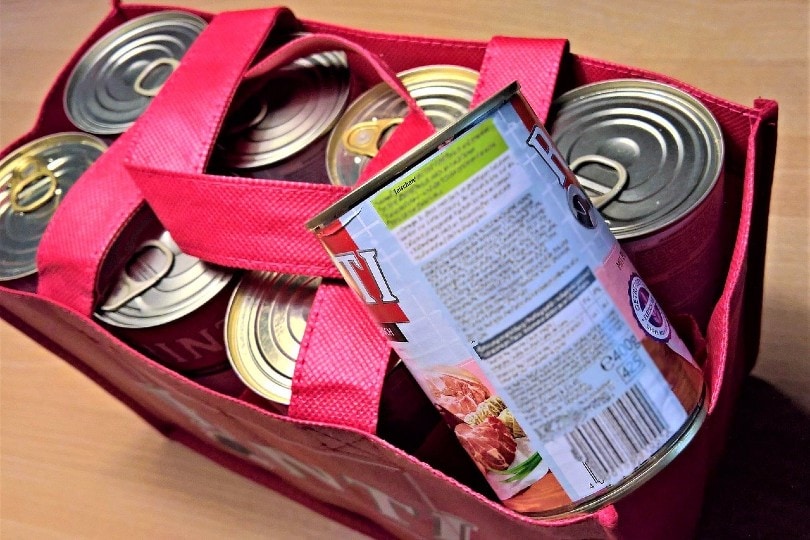
(Pet Food Industry)
People are looking more toward online platforms to do their pet food shopping these days. Increased options with delivery and auto-ship options tend to make owners’ lives a lot easier and can even save them a buck or two thanks to auto-ship and auto-renew programs.
Even though the numbers were through the roof in 2020 due to social distancing restrictions—hitting close to 250,000 people buying pet food via online stores—they are still very high and are expected to rise through 2021. People are using sites like Amazon, Chewy, and private pet food companies to fulfill supply demands.
(Pet Food Industry)
As millennial shoppers continue the surge in online pet food ordering, numbers are projected to increase from this point forward. Research suggests millennials were conditioned to online shop, and therefore, it will continue to grow exponentially.
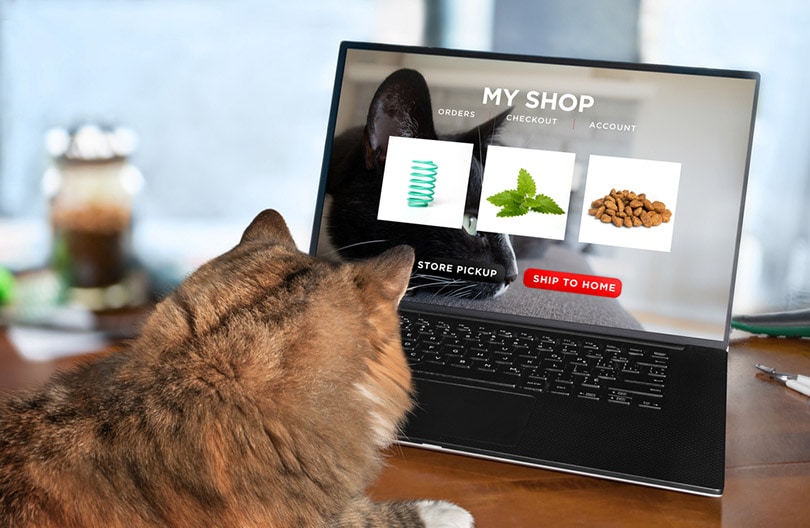
 Nutrition Improvements
Nutrition Improvements
8. Pet supplement sales jumped up to 1.47 billion in 2020 and are predicted to continue rising.
(Grandview Research)
It’s reported that owners spend an average of $58 just on vitamins for their dogs in a year. Sixty percent of owners cashing out for these products are focused on supplements that strengthen their pup’s immunity. In total, 1.47 billion dollars was the total for supplement costs in 2020—and the numbers are expected to continue rising.
Between the years 2021 to 2028, we should see an increase in these numbers of 5.9%.
It’s believed that the drive for pet supplements is due to the humanization of animals. Millennials make up a majority of pet owners, treating their pets like children. So, it is no surprise that supplements are becoming more of a routine part of pet care.
Also, because obesity is becoming such an ongoing problem for pets, affecting 59% of cats and 54% of dogs, weight management supplements are becoming more popular, too.
9. Organic pet food continues to gain popularity, seeing $22.8 billion in sales in 2020.
(IMARC Group)
In 2020, $22.8 billion was spent on organic pet food, and those numbers should keep climbing every year. It is projected that we will see a total increase of 10.6% between 2021 and 2026.
As research continues, more light is shed about dietary care for pets. As nutritionists improve pet food, we see a dramatic increase in organic options, including fresh, raw, homemade, and freeze-dried diets.
Pet food products of years past contained many harsh and harmful additives like pesticides, antibiotics, artificial dyes, and preservatives. Because of the negative impact we see on our pet’s health, organic food may eventually become dominant in the pet food world.

10. The vegan market is projected to grow from US$ 9,302.47 million in 2022 to US$ 15,651.22 million within 7 years.
(Pet Food Industry)
More than 10% of pet owners feed their dogs plant-based diets, while only 3.3% chose this diet for their cats.
While very controversial, vegan pet food options continue to increase in popularity. As animal rights activists attempt to raise awareness of the concepts of meat trades, they want to eliminate meat for their pets’ diets.
These changes can be a little tricky to implement, given that cats are strict carnivores. Replicating a sustainable plant-based diet for a carnivorous animal might have negative consequences, like malnutrition and other health issues.
 The Future of the Pet Food Industry
The Future of the Pet Food Industry
11. The number of households with pets continues to increase, with 70% of all US homes having at least one pet.
(American Pet Products)
Millions of people welcome all sorts of fuzzy, furry, scaly, or feathery friends into their homes and their hearts. Currently, 70% of US households own a pet—translating to 90.5 million homes in total.
- Birds — 9.9
- Cat — 45.3
- Dog — 69.0
- Horse — 3.5
- Freshwater fish — 11.8
- Saltwater fish — 2.9
- Reptile — 5.7
- Small animals — 6.2
With adoption rates climbing, these numbers should only increase over the next generation.
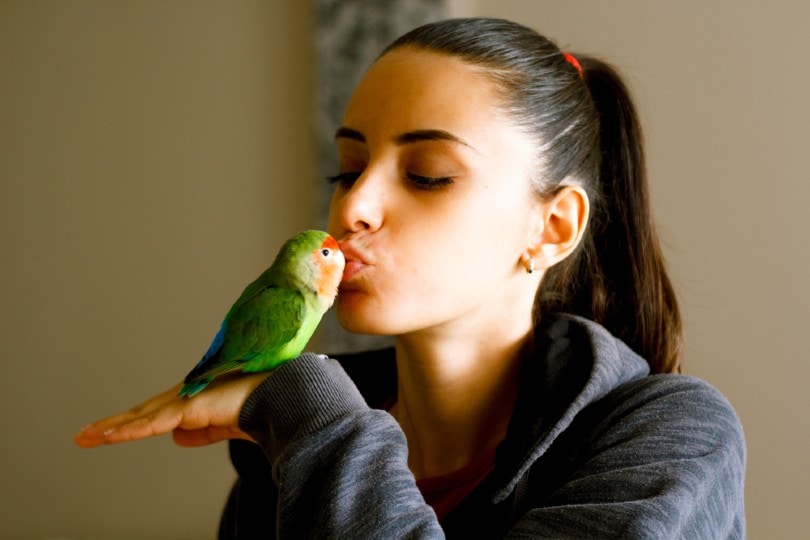
12. Millennials steal the number one slot for pet owners, making up 32%.
(American Pet Products)
- Millennial — 32%
- Baby Boomer — 27%
- Gen X — 24%
- Gen Z — 14%
- Builder — 3%
With younger generations growing up in households that have pets, these numbers should rise, eventually beating out the Millennials.
Since these numbers are expected to keep growing, the pet food industry will be more valuable than ever. Future generations will rely on the convenience of quality pet food care, including supplements, specialized diets, tailored meal plans, and healthy treat options.
13. Pet food production jobs employ nearly 25,000 people and this number is estimated to grow.
(Ibis World)
As the demand grows for everything pet food-related, employment growth in this industry is projected to rise by 1.7% in 2021. As of now, there are an estimated 24,689 pet food production employees in the United States.
Processing and production make up the bulk of these jobs. With the rapid changes in pet food, including the rise in e-commerce shipments, warehouse packaging of food will likely grow as well.
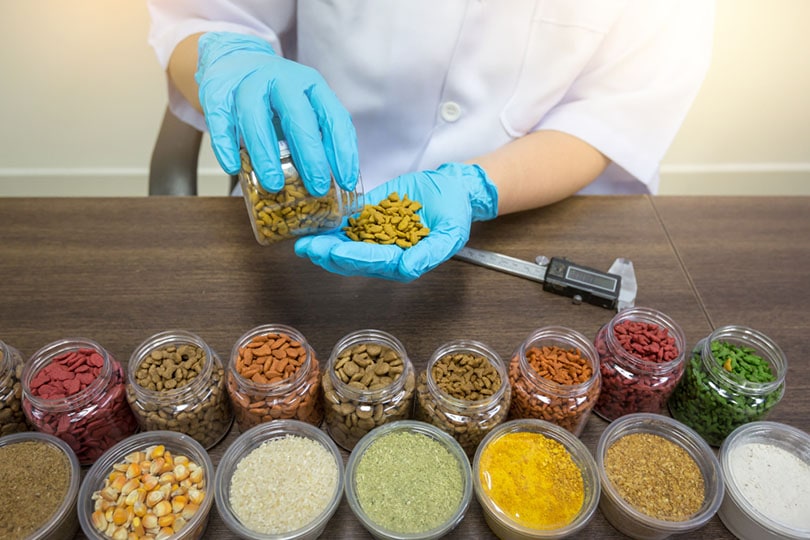
14. Pet food industry companies are thriving in 2022, with Mars Petcare Inc. taking the lead at $18,085,000,000 in total revenue.
(Pet Food Industry)
These are the top 10 pet food companies in the world based on annual revenue:
| Company | Country | Annual Revenue |
| Mars Petcare Inc | United States | $18,085,000,000 |
| Nestle Purina Pet Care | United States | $15,422,000,000 |
| J.M. Smucker | United States | $2,937,500,000 |
| Hill’s Pet Nutrition | United States | $2,525,000,000 |
| General Mills | United States | $1,694,600,000 |
| Diamond Pet Foods | United States | $1,500,000,000 |
| Spectrum Brands/United Pet Group | United States | $951,000,000 |
| Agrolimen SA | Spain | $900,000,000 |
| Unicharm Corp | Japan | $822,000,000 |
| Simmons Pet Food | United States | $1,000,000,000 |
As companies pick up on the demands of pet food consumers, their recipe lines will develop accordingly, generating an additional competitive surge in numbers.
Frequently Asked Questions About Pet Food Industry Statistics
Who approves recipe content for pet foods?
The AAFCO or FDA takes the company’s data based on the recipes they create and analyze their products. If the food meets the needs of the animal, these items are approved. They must meet certain standards and qualifications to be considered, having a minimum required amount of protein, fat, carbohydrates, etc.

What kinds of companies work to improve pet food every year?
Main big-name pet food companies are constantly striving to make food lines that improve the quality of your pet’s life. Many companies which once used fillers and artificial ingredients, for instance, are now creating formulas that are much more natural, making strides towards a better diet. They recognize that owners are willing to pay a premium for higher-quality food for their loved ones.
Also, many small companies have emerged to cater to the needs and demands of owners. This can be very opportunistic for entrepreneurs. When this happens, smaller companies are sometimes bought out by larger companies if they cross a certain threshold of popularity.
Will pet food keep getting more expensive?
If you’ve been paying attention, it seems like pet food just keeps getting more expensive. When you want to give your pet a quality diet, it might be really hard to do if you’re on a strict budget. But sometimes, more expensive pet food doesn’t necessarily mean better quality.
As the market continues to expand and offer more niche products, an increase in top-shelf products will pave the way for higher prices. Just make sure you check the ingredient list to confirm that the contents of the food is worth the cost.
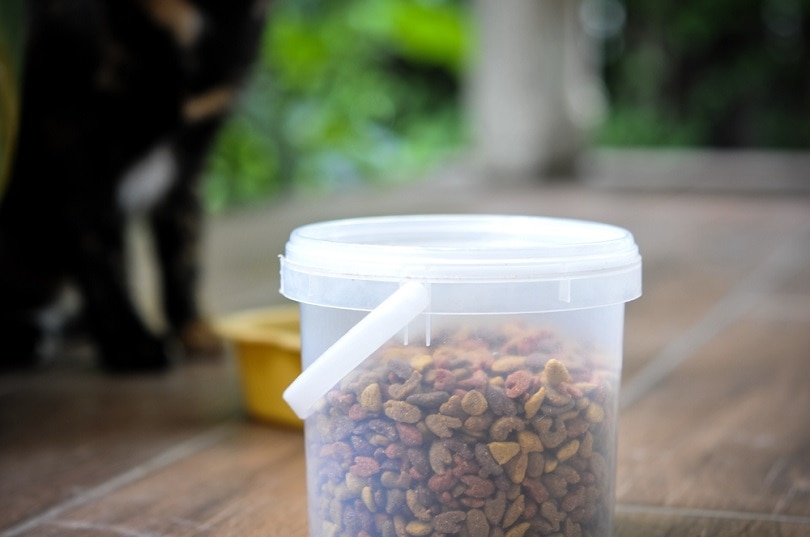
Are there alternatives to commercial foods?
With a rise in homemade pet food options, owners have more control than ever to give their pets a wholesome diet while knowing exactly what is going in their tummies.
Homemade options can actually be much less expensive and much healthier than store-bought options. However, they are much more time-consuming, so this will ultimately boil down to what you can fit into your schedule. As a note, you should always run your homemade diet past your vet to ensure you are providing Fido with all the right nutrients for a healthy lifestyle.
Conclusion
The pet food industry isn’t slowing down anytime soon. It’s going to continue to expand financially without question. In addition, more companies will emerge with comprehensive diet options, supplements, and other food items to increase the vitality of our companions.
With the increase of online purchases, subscriptions, and healthier products, the convenience and quality are likely worth the price to keep your favorite pooch healthy and happy.
Related Reads:
- Largest Pet Food Manufacturers in Canada
- Pet Industry Trends
- How to Start a Dog Food Business
- Pet Food Delivery Service Trends and Statistics
Featured Image Credit: pedphoto36pm, Shutterstock

